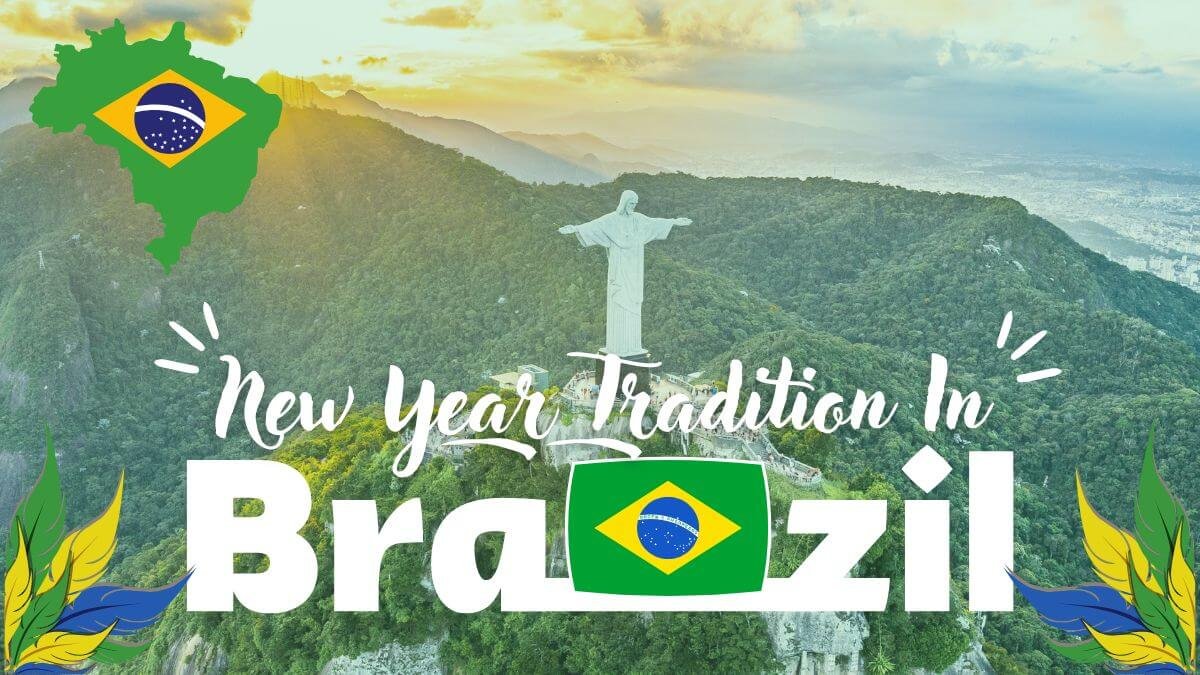New Year’s Eve in Brazil is a vibrant and exciting celebration that showcases the country’s rich cultural diversity. From the lively streets of Rio de Janeiro to the tranquil beaches of Bahia, Brazilians usher in the new year with unique traditions and a festive spirit.
Offerings to Yemanjá:
In the Afro-Brazilian religion of Candomblé, Yemanjá is the goddess of the sea, and her worship is an integral part of New Year celebrations. People often make offerings to Yemanjá, such as flowers, candles, and small boats, which they set afloat on the ocean as a sign of respect and to seek her blessings for the year ahead.
Feasting and Drinks:
No Brazilian celebration is complete without delicious food and drinks. Families and friends come together to enjoy a sumptuous meal that often includes traditional dishes like “feijoada” (a black bean stew) and “farofa” (toasted cassava flour). Of course, there’s plenty of “caipirinha” and champagne to toast to the new year.
New Year’s Resolutions:
Similar to the tradition in many other countries, Brazilians also make New Year’s resolutions. These resolutions are often written on pieces of paper and thrown into the ocean, symbolizing a commitment to positive change and a fresh start.

1. Celebrating New Year’s EVE preferably on the Beach
Welcome to the ultimate guide on celebrating New Year’s Eve on the beautiful beaches of Brazil. Join us as we delve into the sun, sand, and festivities that mark the beginning of a new year in Brazil.
The Allure of Brazilian Beaches
Brazil’s vast coastline boasts some of the world’s most stunning beaches. From Copacabana in Rio de Janeiro to the remote shores of Jericoacoara, there’s a perfect beach for everyone. On New Year’s Eve, these sandy stretches transform into epicenters of celebration and joy.
Live Music and Dancing
On New Year’s Eve, beach parties come alive with live music performances, samba dancers, and capoeira demonstrations. The atmosphere is electric, and everyone is encouraged to join in the festivities.
Feast on Traditional Foods
New Year’s Eve is a time for indulgence in delicious Brazilian cuisine. Seafood, particularly salt cod, is a popular choice. Many also enjoy lentils and pomegranates, as these foods are considered symbols of prosperity and good fortune.
Beachfront Candlelight Rituals
As the night progresses, many people gather in small groups on the beach to light candles in the sand. These candlelit rituals are a way to pay homage to loved ones who have passed away and to bring positivity and light into the coming year.

2. Offering to Ieman, the Goddess of the Sea” and the Mother of Water:
A significant part of these festivities revolves around paying homage to Iemanjá, the revered “Goddess of the Sea” and the “Mother of Waters.”
Iemanjá:
The Goddess of the Sea Iemanjá, often pronounced as Yemanjá, is a prominent figure in Brazilian folklore. She is hailed as the Queen of the Ocean, the protector of fishermen and sailors, and the deity associated with the sea’s mysteries. Her name itself is derived from the Yoruba religion of West Africa, which was brought to Brazil through the African diaspora during the transatlantic slave trade.
New Year Celebrations in Brazil
The Brazilian New Year celebrations are marked by a unique blend of cultural influences, and one of the most captivating aspects is the vibrant tribute to Iemanjá. These celebrations occur primarily along the country’s extensive coastline, where the connection to the sea is strongest.
Offerings to Iemanjá
- Flowers and Jewelry: One of the most common ways to pay homage to Iemanjá is by offering flowers and jewelry. White flowers, particularly roses, are believed to be her favorites. People dress in white and carry these offerings to the shores to throw them into the sea as a sign of respect.
- Candles and Perfume: Lighting candles and perfuming the ocean with various scents is another cherished tradition. It is believed that the light of the candles and the sweet fragrances are pleasing to Iemanjá.
- Boats and Rafts: Elaborate miniature boats and rafts are constructed, often adorned with flowers and other decorations. These symbolize the vessels Iemanjá uses to travel through the sea. They are set afloat with offerings placed on them.
- Music and Dance: Music and dance play a vital role in these celebrations. Samba, a quintessential Brazilian dance, is performed to honor Iemanjá. Drums and other musical instruments are played, creating a lively and rhythmic atmosphere.
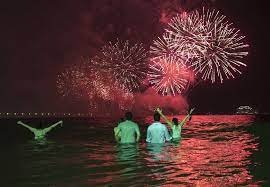
3. Wearing clothes with colorful underwear
. One of the most distinctive rituals is the practice of wearing white clothing with colorful underwear. This tradition embodies the essence of Brazilian culture, blending purity, renewal, and a touch of superstition to welcome the New Year
The Tradition of Wearing White:
Brazilians from all walks of life come together to celebrate the turning of the year. Central to this celebration is the custom of wearing white clothing from head to toe. White symbolizes purity, peace, and renewal in Brazilian culture, and it is believed to bring good luck for the year ahead. People choose their outfits carefully, aiming to start the year with a clean slate and a fresh perspective.
The Role of Colorful Underwear:
While white clothing sets the stage for new beginnings, colorful underwear adds a twist to the tradition. Wearing colorful underwear on New Year’s Eve is thought to attract specific blessings and energies based on the color chosen.
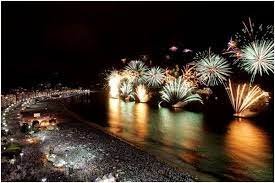
Each color has a unique significance:
- Red: Red underwear is associated with love and passion. Those who wear red are seeking romance and a year filled with passion.
- Yellow: Yellow represents wealth and prosperity. Wearing yellow underwear is believed to bring financial success in the upcoming year.
- Green: Green symbolizes hope and health. People who choose green underwear aim for good health and optimism in the New Year.
- Blue: Blue is associated with tranquility and harmony. Those who opt for blue underwear seek inner peace and serenity.
- Pink: Pink represents friendship and kindness. People wearing pink underwear hope to strengthen their friendships and relationships.
- Purple: Purple is linked to spirituality and mysticism. Those who choose purple are seeking personal growth and a deeper connection with the universe.
- Orange: Orange signifies creativity and ambition. Wearing orange underwear is believed to boost one’s creative endeavors and aspirations.
- Gold: Gold represents success and abundance. People who wear gold underwear are aiming for a year filled with achievements and prosperity.
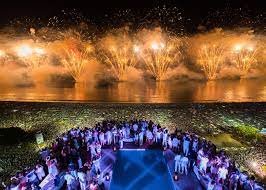
4. The Excitement of Choosing Underwear:
In the weeks leading up to New Year’s Eve, Brazilians are often seen shopping for colorful underwear. The process of selecting the right color is a serious and enjoyable endeavor, as it symbolizes one’s hopes and aspirations for the coming year. Friends and family often engage in discussions and debates over which color to choose, adding to the excitement and sense of unity during the holiday season.
4: Lucky 7’s
In Brazil, this celebration takes on a unique and vibrant character, known for its rich cultural traditions and an abundance of “Lucky 7’s.”
The Significance of 7:
In Brazilian culture, the number seven is considered a symbol of good fortune. It’s believed that the more sevens one encounters during the New Year’s celebration, the luckier their year will be. From wearing white clothing to making offerings to the goddess Iemanjá, Brazilians incorporate the number seven into various aspects of their New Year’s traditions.
White Attire:
On the eve of the New Year, Brazilians of all backgrounds come together to celebrate by wearing all-white attire. This tradition is believed to bring peace and unity among people, as well as a fresh start to the year. Many also add a splash of color by wearing underwear in specific shades to attract love, wealth, and other desired fortunes.
Offerings to Iemanjá:
A central element of New Year’s traditions in Brazil is the offering made to Iemanjá, the goddess of the sea in the Afro-Brazilian Candomblé religion. Devotees believe that offerings such as flowers, candles, and jewelry placed in small boats and set adrift on the water will bring them good luck, love, and protection in the year ahead. This act reflects the deep spiritual connection that many Brazilians have with the sea and its goddess.
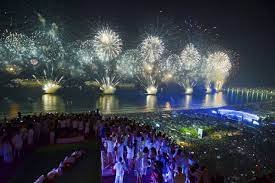
Making Wishes:
At the stroke of midnight, it is customary for Brazilians to make seven wishes, one for each day of the week. They write these wishes on small pieces of paper, fold them, and toss them into the ocean or a nearby body of water. This act is believed to help make these wishes come true in the upcoming year.
5. Cultural Performances in Brazil: A Vibrant Celebration of Traditions
Welcome to the mesmerizing world of New Year Cultural Performances in Brazil! We’ll take you on a journey through the heart of Brazil’s rich cultural tapestry as it comes alive during the New Year festivities. From the rhythmic beats of samba to the spectacular fireworks displays, Brazil’s celebration is a testament to its vibrant and diverse traditions.
The Essence of Brazilian New Year Celebrations
The New Year celebrations in Brazil are not merely about welcoming a new year but embracing a world of traditions that reflect the nation’s multicultural identity. Each region of Brazil has its unique way of celebrating this momentous occasion.
Samba:
The Rhythmic Heartbeat of Brazil Samba, the iconic Brazilian dance, takes center stage during New Year’s celebrations. With its pulsating rhythms and lively choreography, samba performances are a hallmark of the festivities. The infectious energy of samba spreads like wildfire, uniting people from all walks of life.

Colorful Parades and Extravagant Costumes
Brazil is renowned for its grand parades and extravagant costumes, especially during the New Year celebrations. In Rio de Janeiro, the world-famous Carnival-like atmosphere kicks in, with beautifully dressed samba dancers, floats, and lively music adding to the excitement.
A Uniting Spirit
The beauty of New Year Cultural Performances in Brazil lies in its ability to bring people from all walks of life together. Regardless of social or economic background, everyone joins in the celebrations, dancing, singing, and sharing the joy of a fresh start.
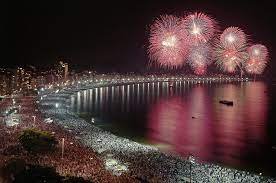
6. To jump seven waves at midnight
In Brazil, a country known for its vibrant and exuberant celebrations, the transition from the old year to the new is nothing short of spectacular. One of the most enchanting customs is the tradition of jumping seven waves at midnight.
Jumping Seven Waves:
At the stroke of midnight on December 31st, Brazilians gather along the country’s magnificent coastline to take part in the exhilarating ritual of jumping seven waves. This tradition is deeply rooted in Brazilian culture and holds a special place in the hearts of the people.
The Significance of Seven Waves
Jumping seven waves is believed to be a way to pay homage to Yemanjá, the goddess of the sea in Afro-Brazilian religions like Candomblé and Umbanda. Yemanjá is considered the protector of fishermen and the source of life’s abundance. The number seven is significant, symbolizing luck and the seven days of the week. Brazilians believe that by jumping seven waves while making seven wishes, they can secure good fortune for the coming year.
Jumping the Waves
At the stroke of midnight, the moment arrives for people to rush into the ocean and jump over the waves. Each wave represents an opportunity to make a wish for the year ahead. It’s a magical sight to witness, as people of all ages, from children to the elderly, enthusiastically participate in this tradition. Many believe that the higher and cleaner the wave they jump, the better their luck will be.
Celebrations Across Brazil:
While the seven waves tradition is widely practiced, various regions of Brazil have their unique customs to usher in the New Year. In Rio de Janeiro, you can witness an impressive display of fireworks at Copacabana Beach, where millions gather to enjoy live music, dance, and merrymaking. In the Northeastern city of Salvador, people participate in a massive street party known as “Carnival of the Streets,” featuring music, parades, and elaborate costumes.
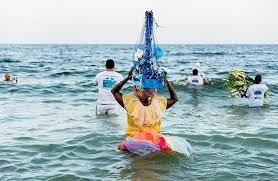
7. Fireworks
The Brazilian New Year’s tradition is filled with rich cultural significance, and it’s complemented by a dazzling fireworks display that lights up the skies, making it an event not to be missed.
Spectacular Fireworks Displays:
One of the most anticipated and breathtaking aspects of the Brazilian New Year’s celebration is the fireworks display. It’s a tradition that dates back several decades and has become an integral part of the festivities. As the clock inches closer to midnight, people gather on the beaches, at iconic landmarks, and in city squares to witness the dazzling spectacle.
The Brazilian fireworks displays are known for their grandeur and creativity. The pyrotechnic shows light up the skies in a kaleidoscope of colors, forming intricate patterns and breathtaking scenes. It’s a visual feast that leaves onlookers in awe, and the tradition has only grown more extravagant over the years.
Fireworks on Copacabana Beach:
Copacabana Beach in Rio de Janeiro is perhaps the most famous location to witness the New Year’s fireworks display. The beach is transformed into a vibrant and festive setting, with millions of locals and tourists coming together. As the clock strikes midnight, a spectacular show of fireworks illuminates the beach and the iconic Sugarloaf Mountain, creating an enchanting atmosphere.
8: Most Popular New Year Foods in Brazil
A: Grapes
In Brazil, the New Year is welcomed with a unique tradition involving grapes. As the clock strikes midnight, many Brazilians partake in the custom of eating 12 grapes, each representing one month of the upcoming year. Each grape is consumed at the chime of the clock, symbolizing a wish or resolution for the corresponding month. It’s a delightful and flavorful way to kickstart the New Year with hopes and positivity.
B: Pomegranates
Pomegranates are not native to Brazil, but their symbolism has found its way into the country’s New Year traditions. The fruit’s vibrant, jewel-like seeds are seen as a representation of prosperity and good fortune. Some Brazilians incorporate pomegranates into their New Year’s celebrations, believing that by doing so, they’ll invite wealth and happiness into their lives in the coming year.
C: Pork
Pork dishes, especially roasted pig, hold a special place in Brazilian New Year celebrations. The fat content of pork symbolizes abundance and prosperity, making it a popular choice for the New Year’s Eve feast. Many families and friends gather to enjoy a sumptuous pork dinner, believing that it will bring luck and plenty in the year ahead.
D: Champagne Livens
Champagne is synonymous with celebrations worldwide, and Brazil is no exception. When the clock strikes midnight, Brazilians raise their glasses, toasting with champagne or sparkling wine to usher in the New Year. The effervescence of these beverages signifies joy and excitement, and the tradition brings people together to celebrate the turning of the calendar with enthusiasm.
E: Rice
Rice is a staple in Brazilian cuisine and is often included in the New Year’s Eve feast. It is believed that consuming rice on this night brings tranquility and harmony to one’s life in the upcoming year. Whether it’s part of a seafood dish or a hearty stew, rice plays a vital role in the Brazilian New Year’s culinary traditions.
F: Lentils
Lentils have long been associated with New Year’s traditions in Brazil, symbolizing prosperity and good luck. Many Brazilians prepare lentil-based dishes for their New Year’s Eve meals, hoping that the small, round legumes will bring financial success in the year to come.
G: Toast with Sparkling Wine
A New Year’s Eve celebration in Brazil wouldn’t be complete without a heartfelt toast. As the clock approaches midnight, friends and family gather, clinking their glasses filled with sparkling wine or champagne. The clinking of glasses is accompanied by wishes for a year filled with health, happiness, and success.
9. Parintins Folklore Festival
New Year’s celebrations in Brazil are a mesmerizing blend of diverse cultural influences, rich traditions, and vibrant festivities. In this article, we will explore some of the most iconic celebrations in Brazil, highlighting the captivating Parintins Folklore Festival, Rio Carnival, Festa Junina, New Year in Rio, and the lively Oktoberfest.
Rio Carnival:
The Rio Carnival is the world’s largest and most famous carnival celebration. This grand spectacle brings millions of people together to revel in colorful parades, samba dances, and extravagant costumes. Learn about the history and significance of this iconic event, as well as how it has evolved into a global sensation.
Parintins Folklore Festival:
The Parintins Folklore Festival is a unique and enchanting celebration that takes place in the heart of the Amazon rainforest. Explore the vibrant folklore, dramatic performances, and mythical tales that make this festival a captivating experience. Discover the cultural significance of this event and its deep-rooted traditions.
Festa Junina:
Festa Junina is a lively Brazilian festival that pays homage to rural life and the feast of St. John. This celebration is characterized by colorful decorations, traditional dances, delicious food, and joyful music. Delve into the customs and regional variations that make Festa Junina an integral part of Brazilian culture.
New Year in Rio:
New Year’s Eve in Rio de Janeiro is a magical experience like no other. Learn about the superstitions, customs, and rituals that Brazilians follow to welcome the new year with positivity and joy. Discover the breathtaking fireworks display at Copacabana Beach and the significance of wearing white attire for good luck.
Oktoberfest:
Brazil’s Oktoberfest, held in Blumenau, is a lively and authentic tribute to German culture. Explore the origins of this beer-filled celebration, the traditional music, and the mouthwatering cuisine. Understand how Brazil has put its own unique twist on this German festival, making it a one-of-a-kind experience.
10. Top and Best Places to Celebrate Parties New Year in Brazil:
New Year’s Eve is a time of joy and festivity around the world, and Brazil is no exception. With its vibrant culture and diverse landscapes, Brazil offers an array of unique and exciting places to celebrate the arrival of the new year
A: Rio de Janeiro City:
Rio de Janeiro is undoubtedly one of the most famous New Year’s Eve destinations in the world. The city hosts an awe-inspiring fireworks display at Copacabana Beach, attracting millions of locals and tourists. The vibrant atmosphere, live music, and samba dancing make this event an unforgettable experience.
B: Copacabana Beach:
Copacabana Beach in Rio de Janeiro is an iconic spot for welcoming the new year. The beachfront fireworks show, combined with the rhythmic sounds of samba, creates a mesmerizing and unforgettable celebration.
C: Porto Seguro:
Porto Seguro in Bahia is known for its lively New Year’s celebrations. It offers a unique mix of indigenous, African, and European traditions. The festivities here are colorful and spirited, with music, dance, and fireworks lighting up the night.
D: Garopaba, Santa Catarina:
For a more tranquil New Year’s experience, Garopaba in Santa Catarina is an excellent choice. This charming coastal town offers a peaceful and serene celebration by the sea, making it ideal for those looking for a more laid-back holiday.
E: Paraty, a Lovely Colonial Town in Rio de Janeiro State:
Paraty is a picturesque colonial town with cobblestone streets and charming old-world architecture. It’s a fantastic place to experience a traditional Brazilian New Year, complete with local music and cultural displays.
F: Porto Seguro, Bahia:
Porto Seguro, with its stunning beaches and rich cultural heritage, offers a dynamic New Year’s celebration. The festivities here combine Brazilian traditions with a vibrant beach party atmosphere.
G: Visconde de Maua, Rio de Janeiro:
If you’re seeking a peaceful and close-to-nature New Year’s experience, Visconde de Maua in Rio de Janeiro is the place to be. This mountainous region is perfect for a serene retreat to start the year afresh.
H: Ouro Preto, Minas Gerais:
Ouro Preto, a historical city in Minas Gerais, combines its colonial charm with a lively New Year’s celebration. The city’s streets come alive with music, dance, and traditional food during this festive time.
I: Alter do Chão, Pará:
Located along the Amazon River, Alter do Chão offers a unique New Year’s celebration. The beachfront area is transformed into a hub of activity, with live music and cultural displays.
J: Salvador, Bahia:
Salvador, the capital of Bahia, is famous for its extravagant Carnival, and its New Year’s celebration is no less grand. The city hosts massive parties, with live music and fireworks illuminating the night sky.
K: São Miguel dos Milagres, Alagoas:
São Miguel dos Milagres is a hidden gem on the Brazilian coast, perfect for those looking for a tranquil and unspoiled New Year’s retreat. The pristine beaches and clear waters offer a serene setting for reflection and celebration.
L.: Trindade, Rio de Janeiro:
Trindade, located near Paraty, is a beautiful coastal village where you can experience a more intimate and relaxed New Year’s celebration.
M: Jericoacoara, Ceará:
Jericoacoara is a breathtaking beach destination in Ceará, and it’s known for its stunning dunes and laid-back atmosphere, making it an excellent choice for a serene New Year’s escape.
N: Ilha Grande, Rio de Janeiro:
Ilha Grande is a tropical paradise with lush rainforests and crystal-clear waters. It’s a perfect location for a tranquil New Year’s celebration surrounded by natural beauty.
O: Boipeba, Bahia:
Boipeba, a tranquil island in Bahia, offers a peaceful New Year’s getaway. The pristine beaches and relaxed ambiance make it a hidden treasure for those seeking a serene celebration


